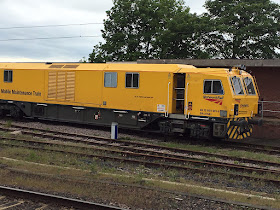The
EM2 electric locomotive (later
Class 77) was built to haul express passenger services over the Woodhead route, which had been electrified to 1,500v DC overhead) alongside the mixed-traffic
Class 76. The Class 77 was based on the Class 76 though larger and more powerful and had Co-Co bogies - a result of the ride problems the Class 76 Bo-Bo bogies had at speed [1].
Originally twenty seven locomotives were planned but in the end only seven were, some later build Class 76s were instead fitted with train heating boilers and improved bogies for passenger duties.
| Information |
| Number built: |
7 |
| Built: |
1953-54 |
| Builder: |
BR Gorton |
| Motor: |
6 Metropolitan-Vickers 146 traction motors (1500kV DC OLHE) |
| Power: |
2, 490 hp (1, 857 kW) |
| Wheel arrangement: |
Co-Co |
They entered service in the mid-1950s hauling expresses between
Manchester Piccadilly and
Sheffield Victoria [2]. However their British Railways life was short. They were withdrawn in 1968 as passenger services along the Woodhead route were phased out (the line and the Class 76 remained in service for freight until 1981).
Happily the still fairly fresh locomotives found a buyer. They were sold to the Dutch railway operator Nederlandse Spoorwegen and became the
NS 1500 class. They received new headlights and pantographs and remained in service until 1986. Three have been preserved.
 |
| NS 1505 now preserved at MOSI Manchester |
 |
| In NS service the locomotives received new cab light clusters |
 |
| The locomotives retained their original BR names in Dutch service |
 |
| Side view of 1505, in BR service the Class 77 had cross-arm pantographs |
 |
| Another view of 1505 |
 |
| The locomotive was E27001 in BR service |
[1] Brian Haresnape, Electric Locomotives (Ian Allan, 1983) p. 32
[2] Colin J. Marsden, Diesel & Electric Locomotive Recognition Guide (Ian Allan, 2011) p. 214























































